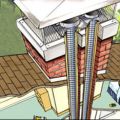WOOD STOVE INSTALLATION

You have selected a wood stove to heat your home. What’s involved with a wood stove installation? Let’s start with what is required to evacuate the products of combustion.
Chimney Selection
Chimneys will be either lined masonry or a Class A (High Temperature) insulated metal, commonly called “all fuel” chimney pipe. The class is assigned by the Underwriter’s Laboratory (UL), the organization for safety science.
Wood Stoves and Fireplace Chimneys
Woodstoves often are installed in lined(full or partial) fireplace chimneys. If the chimney is not lined, fire laws will require it.
Some cautions about using the fireplace chimney for a woodstove: don’t use prefabricated fireplaces that have little or no clearance from the firebox.
Stovepipes
The interiorstovepipe is the connection between your stove and the approved chimney.A stovepipe is made of black sheet metal and takes the smoke and gasses vertically through a roof or connected to a chimney. That stovepipe may have a damper connected, and comes in single or double wall units.
The exterior stovepipe will be insulated piping used on the outside of the building where a fireplace or other chimney are not used.
Clearances are very important for stovepipes. The Underwriter’s Laboratory specifies a clearance of eighteen inches from a wall or a ceiling to allow heat dispersion. This can be modified with the use of heat shields or double-wall stovepipe.
Floors and Walls
Whatever the stove is set on, it must be noncombustible. Metal flooring is often used. The Underwriter’s Laboratory recommends that all noncombustible flooring must be at least 8 inches wider at the sides and 18 inches in front of the loading doors.UL recommends heat shields on the wall sides of the stove.
Safety
Safety is the primary consideration for a wood stove installation. There are National Fire Protection Association (NFPA) standards and local building codes to follow.
Installation Methods
Single story woodstove installation requires the black stovepipe to connect either with a chimney or with an insulated chimney at a support box below the ceiling level. Above the ceiling and the roof, chimney pipe will be installed until the height is at least three feet above the roof and at least two feet higher than other parts of the building. Tall, straight, chimneys work better and give better draft.
A variation of this will be the installation of the system where the roof is so slanted a flush ceiling installation is impossible. Your stove professional will know how.
The second type is for insulated pipe alone, where the stovepipe is passed through a wall, connects to the insulated support box on the exterior wall of the building. Then the insulated pipe is added, conforming to the scenario above. All chimneys should be capped.
Masonry Chimneys
There are two ways that wood stoves can be correctly installed in masonry chimneys:
• Sealed and vented into the firebox (and up the existing chimney).
• Connected to insulated pipe, which then travels up the existing chimney.
If you are going to vent your wood stove up an existing fireplace chimney, the flue liner must be at least the size of the stovepipe that connects the stove to the fireplace.
It works best if the chimney is located inside the building, rather than on the periphery. In all cases, it should be insulated with masonry insulation.The flue liner must allow for expansion. A “cast-in-place” liner will do this admirably.
The safest masonry use for a wood stove is to line that masonry chimney with stainless steel pipe, particularly for installation in a chimney with an outdoor exposure. Again, no wood stove in a metal fireplace.
Damper and Chimney Cap
When it was operated as a fireplace, there was a damper to control the airflow up your chimney. When the fireplace cooled, the damper was closed to keep the heat in the building. Installation of a stove removes the need for that damper. You must now install a blocking plate, which must be fabricated.
For More Info About Wood stove installation Visit Us.
Source: Click Here




